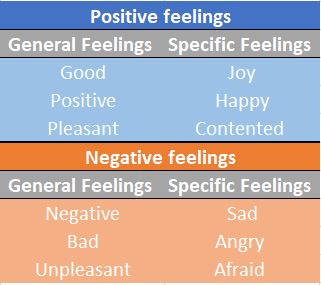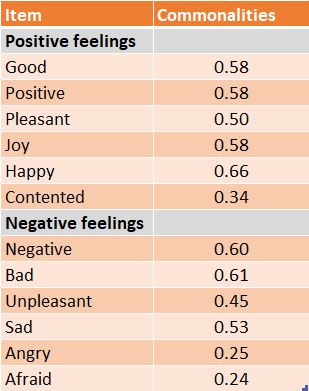We have suspected for centuries that our thoughts and emotions can actually produce energy that can affect reality and matters. Quite recently, a study from Standford University finally confirmed this idea.
According to the study, our thoughts aren’t passive observers perceiving reality as it is but are actually active. With strong enough motivations and consistency, our thoughts and emotional energy can actually shape reality, bringing reality closer to what we are thinking (and wanting).
Here, we will learn how the vibrational frequency of thoughts and emotions can help shape reality, how you can leverage different emotional frequencies, and what are the latest researches in this field.
Without further ado, let us begin.
Thoughts and Emotions
First, what is a “thought”, and what is an “emotion”?
While we can be technical and use all sorts of difficult words to explain them, the simplest way to illustrate them is this way:
Emotion is our mind’s natural instinctive state as a result of external stimuli. These stimuli can be circumstances, relationships with others, mood, and other forms. A feeling is our experience of the emotion and its context, while thoughts are ideas and opinions we use to describe the emotion and feeling.
Thoughts are mental cognition that comes in various different forms like ideas, opinions, and beliefs, which are produced based on how we perceive our surroundings. Different people might have different thoughts when faced with the same stimuli based on their point of view. In turn, these perspectives are influenced by life experience, environment, knowledge, and other factors.
For example, let’s say we are watching a film with a sad scene. This is a stimulus, and it causes us to feel sad (emotion). Based on our knowledge and past experience, our thoughts about this particular scene may differ, and so we may process the sadness differently.
For some, the thought can be as simple as “I really pity this guy, why is this so sad..”. However, those who have experienced similar situations to what the scene has described may process the scene differently, and this scene may act as an emotional trigger.
We can see how the same stimulus may produce similar emotions, but different thoughts. On the other hand, what we think about and how we process our thoughts may also affect how we feel, turning it into a causal cycle.
Check out our collection of “Free Online Audiobooks” and many free resources in our “Free Library”
Thought and Emotional Energy
Now that we’ve understood the basics of how our thoughts and emotions work and how they affect each other, now we’ll learn about the energy produced by these thoughts and emotions.
All humans can manifest energy not only through their bodies (i.e. when we punch something) but also through their minds: thought and emotional energy.
In itself our emotional energy is neutral, but it is our thoughts (how we interpret this emotional energy) that will make it positive or negative. For example, emotions we label as anger will be perceived as negative energy.
We can view our emotional energy as the carrier waves for our feelings, and like any other energy, our emotional energy is a valuable resource that should be used and released rather than suppressed and/or ignored.
Emotional energy will influence our thought processes, memories, experiences, and decision-making. A study by Unilever has suggested that our emotional energy is linked to the primitive (instinctive) part of the brain, that has existed before our rational, thinking part of the brain. Meaning, if we can better manage our emotional energy, we’ll have an easier time regulating our feelings about ourselves, our lives, our work, and other things.
How we understand, manage, and effectively use emotional energy is vital to manage our happiness levels.

Vibrations of Your Thoughts and Emotional Energy
Our thoughts and emotions produce vibrations within our bodies.
Human bodies operate with rhythms or patterns: heartbeats, circadian rhythms, breathing rates, are examples of measurable rhythms in our bodies.
However, at a much smaller scale, vibrations also happen at a cellular level. Each one of our cells vibrates with unique frequencies. With advancements in technologies, now we can observe molecular vibrations within our cells using atomic force microscopes, that are able to detect vibrations on very small molecules.
A study has suggested that these vibrations generate electromagnetic energy, which can affect our cells and on a bigger level, how our body functions.
These vibration frequencies can be faster or slower depending on the stimuli. Higher temperatures, for example, can speed up molecular vibration.
Apparently, many experts also believe that the vibration frequencies are also affected by our thoughts and emotions. On the other hand, manipulating these vibrations can also affect how we think, how we feel, and even our physical health.
Related reading: What Happens When You Raise Your Vibration? – Opens in new tab
Measuring the Frequency of Positive and Negative Emotions
One of the goals of positive psychology is to investigate the causes and effects of happiness. High subjective well-being is usually defined as frequent positive emotions, few negative emotions, and a high level of satisfaction with life in general.
Several scales have been made to measure how happy or sad someone is. But many of the existing measures aren’t good enough because they aren’t reliable or because they don’t show convergent or discriminant validity.
One of these scales is the Scale of Positive and Negative Experience, or SPANE. It uses two 6-item subscales to measure how often positive and negative emotions happen. Both subscales are made up of three adjectives that describe broad feelings (e.g., pleasant/unpleasant) and three adjectives that describe particular sensations (e.g., joyous/sad).
Participants (689) were asked to rate how frequently they had felt this way in the previous four weeks on a 5-point scale ranging from 1 (extremely seldom or never) to 5 (very often or always). Scores for each subscale are totaled together, resulting in a total range of 6 to 30 for both subscales. (Study 1, Study 2)

This method takes into account all kinds of feelings by using labels like “good” and “positive” and “bad” and “negative” to measure the full range of possible good and bad experiences.
The scale has been shown to be sensitive to emotionally important life events and complex interventions like training to improve subjective well-being.
According to the findings of the study, people with higher subjective well-being are healthier, exhibit more adaptive health behavior, and are more productive at work.
This is beneficial in many aspects of people’s lives and the operation of organizations. One fundamental question is how to promote subjective well-being in a sustainable way. Politics, organizational growth, educational institutions, and the promotion of health are a few areas of particular importance.
In the table below, you can see the results of this study.

It’s worth noting that the items with the lowest commonality for the negative experiences were “afraid” and “angry.” These are two specific feelings that are usually included in tests of emotions.
Items like “bad” and “negative,” on the other hand, appeared to substantially reflect negative sentiments. This is significant because it shows that many distinct negative emotions employed in other studies may not adequately reflect the variety of negative feelings.
Research continues with more detailed studies in this field. It is beneficial to follow it as closely as we can, in an attempt to understand more and more about our emotions and how we can manage them for our own well-being.
Devices that Can Read Your Emotions
Can we create devices that detect our emotions? Emotion recognition is a growing field that has caught the attention of both business and academic researchers.
MIT researchers have developed a method for detecting human emotions only using radio frequencies. The researchers bounced waves off individuals to evaluate their breathing patterns and heart rates using the EQ-Radio, which emits and records reflected radio frequency (RF) waves.
Using an algorithm built to correlate physical factors with a variety of emotional signifiers, the data was then used to classify the person’s emotions into one of four categories: sadness, anger, pleasure, or joy.
For this experiment, the researchers at MIT used a group of 12 people and placed them around three to four feet away from the apparatus. The individuals were asked to think back on a personal event that elicited a certain feeling. This produced a ” base emotion,” or an emotion that the researchers could test to determine if the system could detect it.
A baseline may be drawn from the “base emotion” provided by that individual, or it could be based on baselines drawn from the other 11 participants’ reports of their emotional states in order to make future predictions. After that, each person was asked to recollect events that elicited one of the four emotions the system could detect, and the apparatus measured heart and respiration rates in two-minute sequences for each emotion, resulting in a total of 400 segments for the 12 individuals.
The EQ-Radio predictions were surprisingly accurate, especially when based on one person’s baseline. Here the algorithm was 87% right in predicting emotions. When the algorithm predicted based on other people’s emotions, it was 72 percent correct.
The researchers also discovered that heart rates, rather than breathing rates, were a better predictor of an individual’s emotional state.
The ΜΙT researchers remark that the results were equivalent to an ECG, or electrocardiograph, which detects emotions via electrical impulses picked up by electrodes placed on a user’s body. However, the novel technology eliminates the need for researchers to attach electrodes to your body in order to evaluate your emotions. Thanks to this kind of technology, machines will be able to communicate with people in a way that is more like how we communicate with each other.
Smart homes would respond to our moods by changing the music or lighting as necessary. Better tools for evaluating user experience would be available to filmmakers. Advertisers would receive rapid feedback from customers. Computers would be able to automatically identify bipolar disorder, anxiety, and depression symptoms, enabling early treatment of these diseases.
End Words
Everything is energy. It starts with your ideas. Your emotions amplify it, and your actions accelerate it. Look into it for yourself. Be an observer of your own thinking stream. When you learn to shift from thinking to awareness, you suddenly discover that you have control over your thoughts and emotions.
Check out our recommendations at “Mind Training Bookshelf” and many free resources at our “Free Library“
Stay in Touch
 Join our newsletter by using the forms on this website or click here!
Join our newsletter by using the forms on this website or click here! Follow us on Google News
Follow us on Google News Follow us on Facebook
Follow us on Facebook
Featured Image by Gerd Altmann from Pixabay






